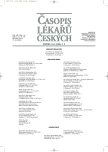Therapy of Acute Myocardial Infarction in Unspecialised Medical Centres – Evaluation of Diagnostic and Therapeutic Practice
Terapie akutního infarktu myokardu mimo kardiocentrum – zhodnocení diagnostických a léčebných postupů
Východisko.
V České republice v současnosti neexistuje registr akutních koronárních syndromů. K dispozici jsou
pouze data o pacientech s vybranými typy akutního infarktu myokardu, není však jasné, jaká je všeobecná praxe.
Cílem práce bylo jednak zhodnotit a porovnat diagnostické a léčebné postupy u nemocných s akutním infarktem myokardu v nemocnicích Čáslav, Kutná Hora a Znojmo, dále posoudit dodržování aktuálních doporučení v klinické praxi.
Metody a výsledky.
Soubor tvořilo 564 pacientů (300 mužů, 264 žen) průměrný věk 71±11,9 let), u kterých byl v roce 2003 diagnostikován akutní infarkt myokardu. Základní demografická data se mezi nemocnicemi významně nelišila, z rizikových faktorů byla rozdílná jen prevalence kouření (p<0,01). Častější byly infarkty bez elevací úseků ST – 73 %. Reperfuzní terapie byla použita u 67 % pacientů s infarktem s elevacemi ST, jednoznačně převažuje přímá angioplastika (u 63 % pacientů s elevacemi ST ), trombolytická terapie byla aplikována u 4 %. V terapii během prvních 24 hodin byl nejvíce zastoupen aspirin (78 %), heparin (82 %), betablokátory (34 %). Nejčastější komplikací bylo srdeční selhání – u 23 % nemocných. Hospitalizační mortalita se v jednotlivých nemocnicích významně nelišila, v celém souboru byla 15 %. V propouštěcí medikaci byl nejčastěji předepsán aspirin (76 %), dále betablokátory (63 %), inhibitory ACE (58 %) a statiny (54 %), statisticky významná odlišnost mezi jednotlivými nemocnicemi byla pouze v podávání thienopyridinů (p<0,001).
Závěry.
Mezi jednotlivými nemocnicemi byly jen malé rozdíly v léčebných postupech, ve všech třech nemocnicích je patrný odklon od trombolýzy ve prospěch přímé angioplastiky. Běžná praxe ve farmakoterapii nesplňuje vždy současná doporučení pro léčbu infarktu myokardu.
Klíčová slova:
akutní infarkt myokardu, rizikové faktory, reperfuzní léčba, farmakoterapie.
Authors:
Z. Monhart; H. Grünfeldová 1,2; A. Kadlečková 3; P. Janský 4
Authors‘ workplace:
Interní oddělení Nemocnice Znojmo
; Interní oddělení Městská nemocnice Čáslav
1; EuroMISE centrum - Kardio, Praha
2; Interní oddělení Nemocnice Kutná Hora
3; Kardiocentrum dospělých FNM, Praha
4
Published in:
Čas. Lék. čes. 2005; 144: 102-106
Category:
Original Article
Overview
Background.
No general register of patients with acute coronary syndrome is available in the Czech Republic. That is why the everyday clinical practice remains indeterminate. The aim of the study was to compare patients’ characteristics, diagnostic and therapeutic procedures in patients with acute myocardial infarction admitted to three municipal hospitals (Caslav, Kutna Hora, Znojmo) and to assess the correspondence of the local clinical practice with the current guidelines.
Methods and Results.
A total of 564 patients (300 men, 264 women) mean age 71±11,9 years) admitted for acute myocardial infarction was included into the study. No significant difference was found in the demographic data among the hospitals. Higher proportion of smokers was observed in the hospital of Kutna Hora (p<0,01). In the studied sample, the proportion of myocardial infarctions without ST elevation was larger than that without it (311 pts. – 73 %). In the subgroup of patients with myocardial infarction and ST elevation 67 % received some form of reperfusion therapy (primary angioplasty in 63 % and fibrinolytic therapy in 4 %). Most patients received aspirin and heparin (78 % a 82 % respectively) within the first 24 hours; the treatment with beta-blockers was less common (34%). The most frequent in-hospital complication was the heart failure (23 %). In-hospital mortality for all patients was 15%. At the discharge from hospital, patients received flowing treatment: aspirin (76 %), beta-blockers (63 %), ACE inhibitors (58 %), statins (54 %). A significant difference was found only in the use of clopidogrel and ticlopidin (p<0,001).
Conclusions.
This study reveals only minor differences in the management of patients among hospitals and demonstrates some differences between existing guidelines and current clinical practice. The vast majority of patients with acute myocardial infarction with ST elevation was treated by primary angioplasty.
Key words:
acute myocardial infarction, risk factors, reperfusion therapy, medication.
Labels
Addictology Allergology and clinical immunology Angiology Audiology Clinical biochemistry Dermatology & STDs Paediatric gastroenterology Paediatric surgery Paediatric cardiology Paediatric neurology Paediatric ENT Paediatric psychiatry Paediatric rheumatology Diabetology Pharmacy Vascular surgery Pain management Dental HygienistArticle was published in
Journal of Czech Physicians

- Metamizole vs. Tramadol in Postoperative Analgesia
- Metamizole at a Glance and in Practice – Effective Non-Opioid Analgesic for All Ages
- Metamizole in perioperative treatment in children under 14 years – results of a questionnaire survey from practice
- Obstacle Called Vasospasm: Which Solution Is Most Effective in Microsurgery and How to Pharmacologically Assist It?
- Possibilities of Using Metamizole in the Treatment of Acute Primary Headaches
Most read in this issue
- Molecular Genetic Study of Causes of the Prader-Willi and Angelman Syndrome
- Psychiatry is More Than Therapy
- Current and Perspective Treatment of Chronic Lymphocytic Leukemia
- Therapy of Acute Myocardial Infarction in Unspecialised Medical Centres – Evaluation of Diagnostic and Therapeutic Practice
